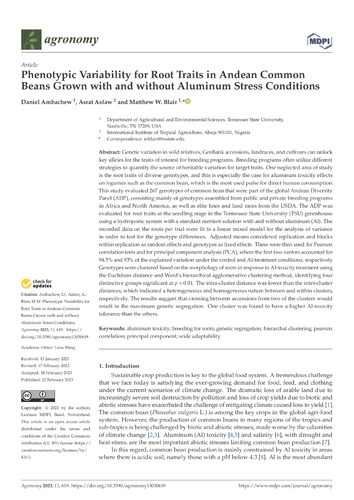Phenotypic variability for root traits in Andean common beans grown with and without aluminum stress conditions
Abstract
Genetic variation in wild relatives, GenBank accessions, landraces, and cultivars can unlock key alleles for the traits of interest for breeding programs. Breeding programs often utilize different strategies to quantify the source of heritable variation for target traits. One neglected area of study is the root traits of diverse genotypes, and this is especially the case for aluminum toxicity effects on legumes such as the common bean, which is the most used pulse for direct human consumption. This study evaluated 267 genotypes of common bean that were part of the global Andean Diversity Panel (ADP), consisting mainly of genotypes assembled from public and private breeding programs in Africa and North America, as well as elite lines and land races from the USDA. The ADP was evaluated for root traits at the seedling stage in the Tennessee State University (TSU) greenhouse using a hydroponic system with a standard nutrient solution with and without aluminum (Al). The recorded data on the roots per trial were fit to a linear mixed model for the analysis of variance in order to test for the genotype differences. Adjusted means considered replication and blocks within replication as random effects and genotypes as fixed effects. These were then used for Pearson correlation tests and for principal component analysis (PCA), where the first two vectors accounted for 94.5% and 93% of the explained variation under the control and Al-treatment conditions, respectively. Genotypes were clustered based on the morphology of roots in response to Al-toxicity treatment using the Euclidean distance and Ward’s hierarchical agglomerative clustering method, identifying four distinctive groups significant at p < 0.01. The intra-cluster distance was lower than the inter-cluster distances, which indicated a heterogeneous and homogeneous nature between and within clusters, respectively. The results suggest that crossing between accessions from two of the clusters would result in the maximum genetic segregation. One cluster was found to have a higher Al-toxicity tolerance than the others.

